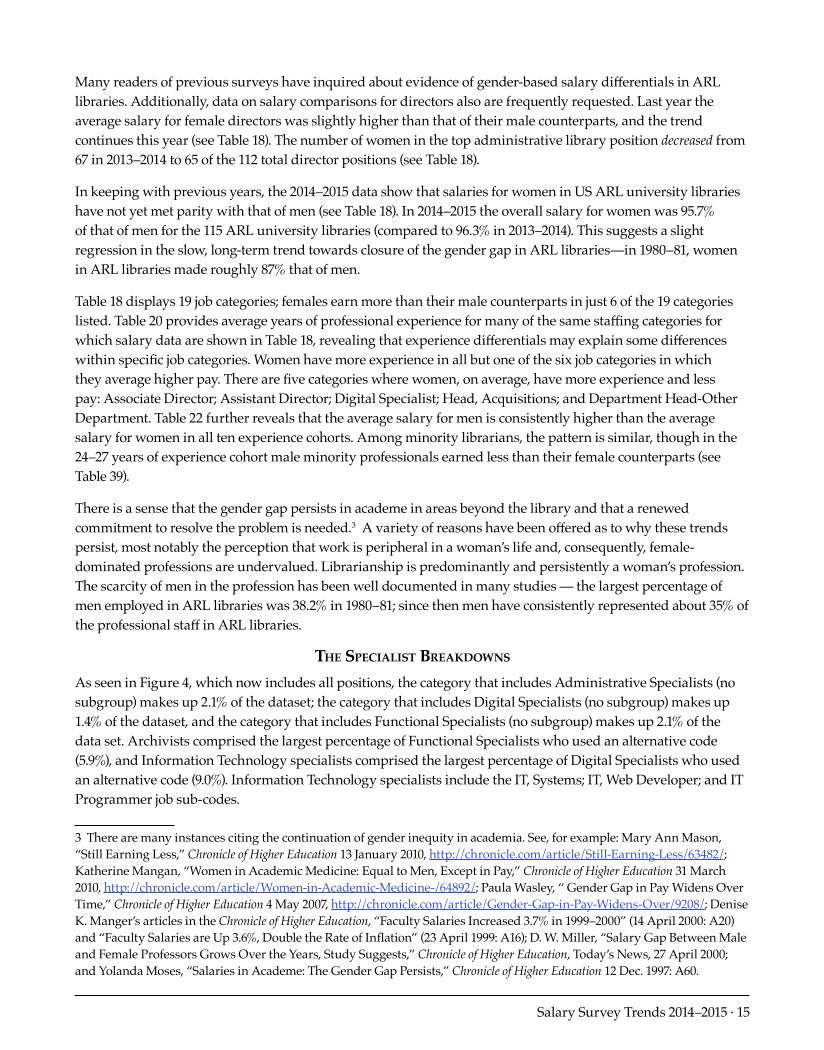Salary Survey Trends 2014–2015 · 15 Many readers of previous surveys have inquired about evidence of gender-based salary differentials in ARL libraries. Additionally, data on salary comparisons for directors also are frequently requested. Last year the average salary for female directors was slightly higher than that of their male counterparts, and the trend continues this year (see Table 18). The number of women in the top administrative library position decreased from 67 in 2013–2014 to 65 of the 112 total director positions (see Table 18). In keeping with previous years, the 2014–2015 data show that salaries for women in US ARL university libraries have not yet met parity with that of men (see Table 18). In 2014–2015 the overall salary for women was 95.7% of that of men for the 115 ARL university libraries (compared to 96.3% in 2013–2014). This suggests a slight regression in the slow, long-term trend towards closure of the gender gap in ARL libraries—in 1980–81, women in ARL libraries made roughly 87% that of men. Table 18 displays 19 job categories females earn more than their male counterparts in just 6 of the 19 categories listed. Table 20 provides average years of professional experience for many of the same staffing categories for which salary data are shown in Table 18, revealing that experience differentials may explain some differences within specific job categories. Women have more experience in all but one of the six job categories in which they average higher pay. There are five categories where women, on average, have more experience and less pay: Associate Director Assistant Director Digital Specialist Head, Acquisitions and Department Head-Other Department. Table 22 further reveals that the average salary for men is consistently higher than the average salary for women in all ten experience cohorts. Among minority librarians, the pattern is similar, though in the 24–27 years of experience cohort male minority professionals earned less than their female counterparts (see Table 39). There is a sense that the gender gap persists in academe in areas beyond the library and that a renewed commitment to resolve the problem is needed.3 A variety of reasons have been offered as to why these trends persist, most notably the perception that work is peripheral in a woman’s life and, consequently, female- dominated professions are undervalued. Librarianship is predominantly and persistently a woman’s profession. The scarcity of men in the profession has been well documented in many studies — the largest percentage of men employed in ARL libraries was 38.2% in 1980–81 since then men have consistently represented about 35% of the professional staff in ARL libraries. The Specialist Breakdowns As seen in Figure 4, which now includes all positions, the category that includes Administrative Specialists (no subgroup) makes up 2.1% of the dataset the category that includes Digital Specialists (no subgroup) makes up 1.4% of the dataset, and the category that includes Functional Specialists (no subgroup) makes up 2.1% of the data set. Archivists comprised the largest percentage of Functional Specialists who used an alternative code (5.9%), and Information Technology specialists comprised the largest percentage of Digital Specialists who used an alternative code (9.0%). Information Technology specialists include the IT, Systems IT, Web Developer and IT Programmer job sub-codes. 3 There are many instances citing the continuation of gender inequity in academia. See, for example: Mary Ann Mason, “Still Earning Less,” Chronicle of Higher Education 13 January 2010, http://chronicle.com/article/Still-Earning-Less/63482/ Katherine Mangan, “Women in Academic Medicine: Equal to Men, Except in Pay,” Chronicle of Higher Education 31 March 2010, http://chronicle.com/article/Women-in-Academic-Medicine-/64892/ Paula Wasley, “ Gender Gap in Pay Widens Over Time,” Chronicle of Higher Education 4 May 2007, http://chronicle.com/article/Gender-Gap-in-Pay-Widens-Over/9208/ Denise K. Manger’s articles in the Chronicle of Higher Education, “Faculty Salaries Increased 3.7% in 1999–2000” (14 April 2000: A20) and “Faculty Salaries are Up 3.6%, Double the Rate of Inflation” (23 April 1999: A16) D. W. Miller, “Salary Gap Between Male and Female Professors Grows Over the Years, Study Suggests,” Chronicle of Higher Education, Today’s News, 27 April 2000 and Yolanda Moses, “Salaries in Academe: The Gender Gap Persists,” Chronicle of Higher Education 12 Dec. 1997: A60.












































































































































































